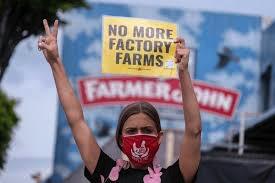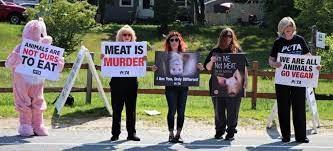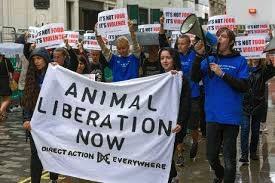Emily Ellis, Manager for Communications at the Animal Agricultural Alliance provided a valuable summary of relevance to Subscribers concerning recent meetings of organizations opposed to intensive livestock production. It would appear from her report that 2024 will bring “more of the same” with respect to action by our opponents.

Direct Action Everywhere (DxE) will continue with intrusions onto farms with the expressed intention of “rescuing animals and birds”. The livestock that they pretend to care for are not really the significant issue but their intent is to generate publicity in order to attract donations for their cause. Basically if the media documents their actions they are heroes. If they are arrested then they are martyrs. Any organization that regards “animal agriculture as a complex machine refined over centuries and designed to torture and destroy all the living being within it” has a decidedly distorted view of the world and food production. If livestock producers were “torturing” their herds and flocks they would not achieve the excellent production results necessary to survive in a competitive market and to supply our nation and those that import our products with inexpensive protein.

The Humane Society of the United States has emphasized the SCOTUS decision to uphold California Proposition #12. This ruling has more impact on the hog industry with their recalcitrance over gestation confinement than on egg production. There has been adequate transition from conventional cages to alternative systems to supply states that have mandated cage-free egg production. On the flip side, HSUS and kindred organizations are extremely worried over the proposed Ending Agricultural Trade Suppression Act (EATS). This legislation would effectively negate required standards arising from voter initiatives with respect to interstate commerce. The EATS Act is framed too broadly and will require considerable modification to eliminate provisions that are contrary to existing federal laws. The question is now one of timing as to whether a more focused version should be considered as a free-standing bill or incorporated into the much-delayed 2023 Farm Bill

Organized agriculture can expect more intensive efforts to engage legislators in issues relating to livestock welfare. Attempts will be made to link livestock production with sustainability and climate change and plant-based alternatives will be promoted to displace red meat, milk and eggs. Legislation will be directed to choke points in the chain of production by imposing unnecessary restraints. An example was concerted opposition to the New Swine Inspection System that contributed to efficiency by increasing line speed and rationalizing inspection. The prolonged litigation associated with this issue illustrated the apparent commonality of purpose among diverse activist groups. There was common cause among labor unions, opponents of  intensive livestock production and environmentalists attempting to block an advantage for packers and ultimately consumers. Similar cooperation is evident in opposition to serving whole milk in schools with dieticians, public health advocates and anti-dairy activists joining forces to promote alternatives. Proposed restrictions on CAFOs with a focus on waste treatment has engendered collusion among environmentalists, welfare activists and public health advocates to lobby the EPA and Congress for upgraded standards that will be expensive and technically challenge to meet.
intensive livestock production and environmentalists attempting to block an advantage for packers and ultimately consumers. Similar cooperation is evident in opposition to serving whole milk in schools with dieticians, public health advocates and anti-dairy activists joining forces to promote alternatives. Proposed restrictions on CAFOs with a focus on waste treatment has engendered collusion among environmentalists, welfare activists and public health advocates to lobby the EPA and Congress for upgraded standards that will be expensive and technically challenge to meet.

During 2024 associations representing animal and poultry producers will be faced with negative publicity in both mainstream and social media. Appropriate rebuttals and where possible preemptive positive material should be developed and posted to counter attacks on the existing and efficient protein supply chain.